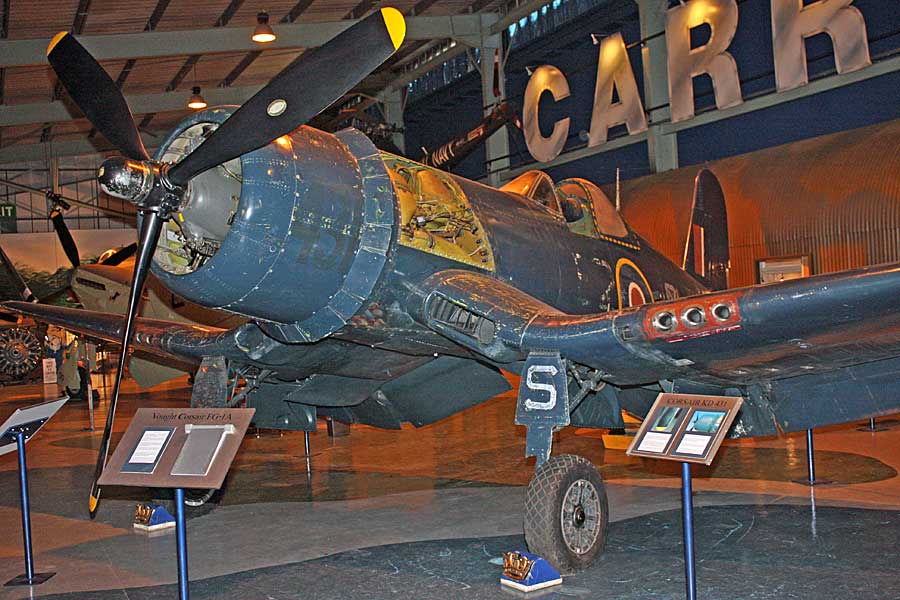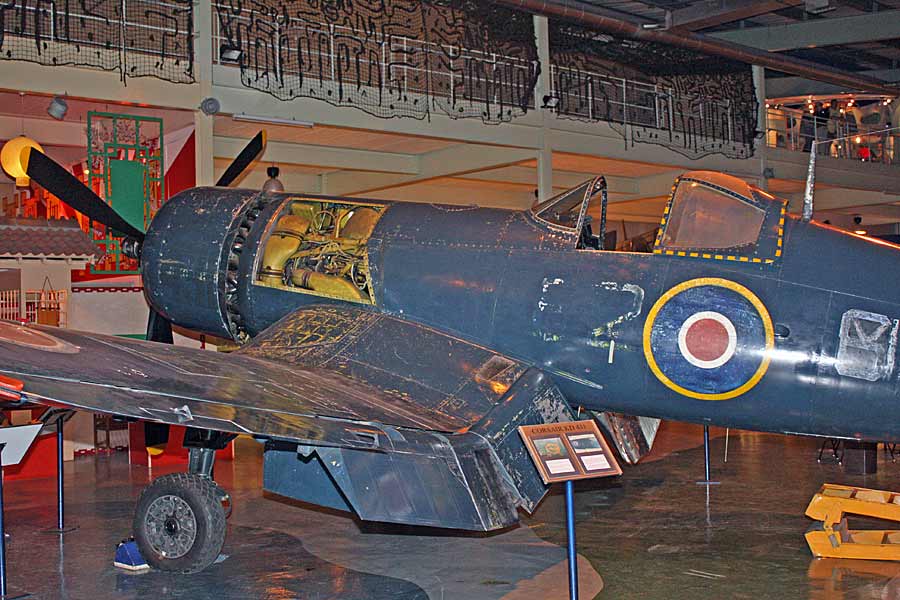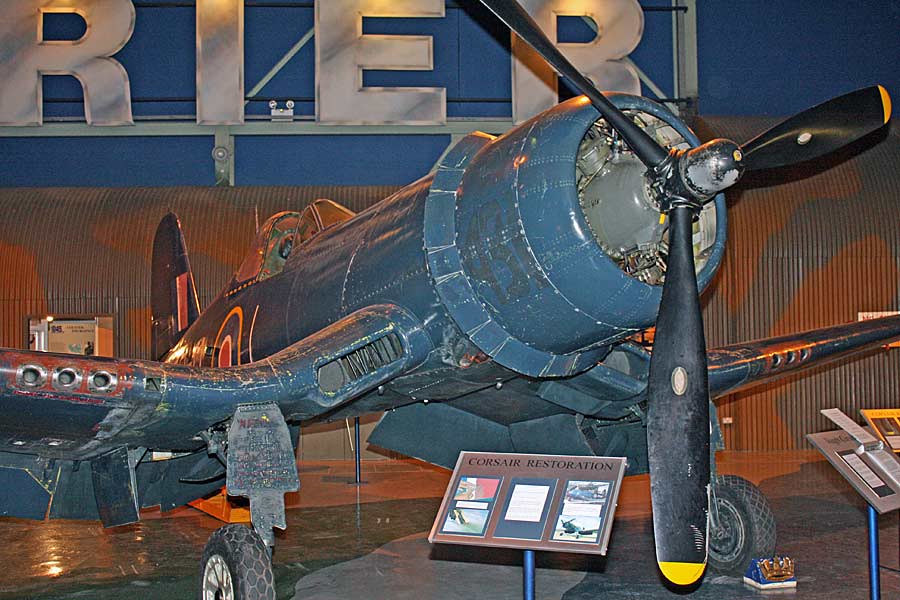





Vought/Goodyear FG-1A Corsair IV KD431 (FG-1A) (14862) [@ Fleet Air Arm Museum]
The Corsair first saw service not with the US Marine Corps,
but it was the Royal Navy’s Fleet Air Arm (FAA) who first operated the type from
its aircraft carriers. The prototype, XF4U- 1, flew for the first time on
29th May 1940 but because of many essential modifications the first
production aircraft did not fly until 25th June 1942. On 2nd
April 1941 Vought received a contract for 584 aircraft, the type to be named
Corsair in US Navy service. Demand for the aircraft soon overwhelmed
Vought's manufacturing capability, resulting in production by Goodyear and
Brewster: Goodyear-built Corsairs were designated FG
and Brewster-built aircraft F3A. Brewster
subsequently built 735 aircraft under the designation F3A-1 (however its
contract was cancelled in 1944 because of shoddy working practices) while
Goodyear built 3808, under the designation FG-1. The Corsair was designed
as a carrier-based aircraft but its difficult carrier landing performance
rendered it unsuitable for US Navy use until the carrier landing issues were
overcome by the FAA. The first Vought built F4U-1 was delivered to the USN
on 31st July 1944. Carrier trials began in September 1942 and
the first Corsair unit, Marine Fighter Squadron (VMF) 214, was declared
combat-ready in December, and were deployed to Guadalcanal in February 1943.
After trials with Fighter Squadron 12 or VF-12, the Corsair became operational
with US Navy Fighting Squadron VF-17 in April 1943, deploying to a land base in
New Georgia in September. Manufacture of the Corsair ceased in 1952
allowing the type to boast the longest production run of any American piston
engined fighter. In total, more than 12,500 F4Us would be built comprising
of 16 variants.
Built by Goodyear at Akron, Ohio, and was first flown on the
22nd August 1944. Allocated to the Royal Navy’s FAA as KD431 and
shipped to Lockheed, Glasgow, during late 1944. KD431 was then allocated to a
number of maintenance units, 23 MU based at RAF Aldergrove on the 8th
November 1944 and 48 MU based at RAF Hawarden on the 15th January
1945 before going to RNAS Stretton, Cheshire, on the 16th January
1945. On the 6th June 1945 KD431 was transferred to NAS 835 based at
RNAS Eglinton (HMS Gannet) in County Londonderry, Northern Ireland.
RNAS Stretton was also the home to the
Naval Air Anti-Submarine School whose main function was to train aircrew in
anti-submarine warfare. From the 31st July KD431 the squadron flew
from here to HMS Patroller for deck landing training in the Clyde exercise
areas. HMS Patroller was a Ruler class escort carrier and was launched on the 6th
May 1943. Formally USS Keweenam, HMS Patroller saw little active service and was
predominantly in the training and transport roles and served in both the
Atlantic and Pacific Theatres. “Loaned” to the US Army as a transport carrier
between the 15th March 1944 and the 2nd May 1944 and later
"loaned" to the US Navy as a transport carrier between the 28th January
1945 and May 1945. Following a refit in Liverpool during June/July 1945 HMS
Patroller sailed up the River Clyde on the 15th August 1945 for conversion to a
troop carrier. During September 1945 KD431 was transferred to NAS 768 based at RNAS Ballhalbert (HMS Corncrake) in North (County) Down, Northern Ireland.
From this base KD431 flew out to HMS Premier in the Clyde exercise areas from
the 17th September to the 27th September for deck landing
training. HMS Premier was also a Ruler class escort carrier and served with the
Home Fleet from November 1944 to May 1945. The type was based on a US C3
merchant hull with HMS Premier (formally USS Estero) being launched on the 22nd
March 1943. Following repairs during June 1945 HMS Premier served as a
deck-landing training carrier until February 1946. Both escort carriers returned
to the US Navy after WW2 and were later sold off as merchantmen. During October
1945 KD431 was transferred with 768 NAS to RNAS East Haven, Angus, Scotland
(HMS Peewit). The last known flight of KD431 took place on the 7th
December 1945. KD431 then entered on the 3rd July 1946 the “College
of Aeronautics” at Cranfield, Bedfordshire. Formally RAF Cranfield, which had opened in 1937, it eventually
became the site for Cranfield University. Finally KD431 entered the FAA museum
during June 1963.


Vought/Goodyear Corsair IV (FG-1D) (88297) [@ RAF Duxford]
Under Lend-Lease the Royal Navy were supplied with 2,012 of
the 12,681 Corsairs built during WW2 and the type equipped 19 FAA squadrons.
However, some of these aircraft were diverted to equip 3 squadrons of the RNZAF
(Royal New Zealand Air Force) operating in the Solomon Islands. 1830 NAS
(Naval Air Squadron) became the first squadron to operate the type when it was
equipped with the Corsair I (F4U-1) variant, which was the first production
version. Formed on the 1st June 1943 at the Naval Air Station
Quonset Point, Rhode Island, and commissioned on the 12th July 1941,
Quonset Point was used from 1943 to train FAA pilots on the type. When
placed into FAA service the type suffered a number of fatal crashes due to its
dangerous landing characteristics. The FAA found that by clipping the
outer wings by 200 mm to clear the deckhead it had inadvertently improved the
sink rate, reducing the F4U's tendency to "float" in the final stages of
landing. Also, the poor visibility when landing was solved by approaching
the carrier in a medium left-hand turn which allowed the pilot to keep the
carrier's deck in view over the dip in the port wing. This technique was
later adopted by U.S. Navy and Marines. In addition, the FAA made a number
of modifications to improve carrier landings. These included the fitting
of a bulged canopy, raising the pilot's seat by 180 mm and wiring shut the cowl
flaps across the top of the engine compartment and diverting the oil and
hydraulic fluid around the sides of the fuselage.
88297 was built by the Goodyear Aircraft Corporation at Akron, Ohio, as an FG-1D with a Pratt & Whitney R2800-8W and delivered to the US Navy on the 9th April 1945. Dispatched on the 11th April to Guam 88297 was assigned to the Marine Air Wing 2 (MAW-2) aircraft pool based at Guam during June 1945 and saw combat in the Pacific during the final two months of the war. After WW2 88297 was transferred back to the US and allocated from June 1946 to various US Naval Air Reserve squadrons and various periods of storage. Identified for disposal 23rd January 1959, having completed a total of 1652 flying hours, 88297 was purchased later in the same month by ALU-MET Smelters. Eventually saved from the smelters on the 9th January 1960 by the stunt-pilot Frank Tallman, 88297 then passed through a number of other civilian owners before arriving at RAF Duxford in April 1986. In the photographs 88297 is painted in the livery of KD345 of 1850 NAS based on HMS Vengeance of the Pacific Fleet in December of 1945. 1850 Squadron had formed at Brunswick, Maine, USA (HMS Saker) on the 1st August 1944. On the 10th February 1945 1850 NAS joined HMS Venerable, a Colossus Class Light Fleet Carrier. Built by Swan Hunter on the River Tyne, HMS Venerable had entered service with the Royal Navy on the 15th January 1945. The squadron left for the UK on the 11th June 1946 and was disbanded upon arrival at Gosport on the 12th August 1946. During the period 1945 to 1946 HMS Vengeance embarked 24 Corsairs from 1850 NAS.

Vought/Goodyear Corsair IV NZ5648 (FG-1D) (92044/88391) [@ RAF Duxford]
The Corsair provided the FAA with a versatile aircraft to
the two-seat Blackburn Skua and Fairey Fulmar, which provided the range needed
for carrier operations but lacked the performance, while the
Supermarine Seafire and
Hawker Sea Hurricane lacked the range but provide the performance. In total
95 Corsair Is and 510 Corsair IIs (F4U-1As) were delivered
by Chance Vought to the FAA. Brewster supplied 430 F4U-1Ds as
Corsair IIIs (F3A-1Ds) to the FAA while
Goodyear supplied 977 F4U-1Ds as Corsair IVs (FG-1Ds). The type first experienced action on
the 2nd April 1944 when the Corsair IIs of 1834 NAS, based on HMS.
Victorious, supplied top fighter cover for Fairey Barracuda bombers attacking
the Tirpitz at Kaa Fjord, Norway, in operation Tungsten. 1842 NAS supplied
fighter cover for further strikes against the Tirpitz in the following July and
August. However, most of the Royal Navy’s Corsairs spent most of WW2 in the
Indian Ocean and later in the Pacific. The first action for the type was on the
19th April 1944 when the port of Sabang, on the north-western tip of Sumatra in
the Dutch East Indies, was attacked. The strike force consisted of 17 Fairey
Barracuda bombers and 13 Vought F4U Corsair fighters from HMS Illustrious and 29
Douglas SBD Dauntless and Grumman TBF Avenger bombers with 24
Grumman F6F Hellcat fighters from the USS Saratoga. Later the type saw action against
Kamikaze attacks as the Royal Navy attacked the Sakishima Islands. Operating
from HMS Victorious and HMS Formidable NAS 1834, 1836, 1841 and 1842 attacked
during July and August 1945 the Japanese mainland, near Tokyo. The Mk IIs and Mk
IVs were the only variants to be used in combat during WW2 with the FAA.
Built as a FG-1D Corsair in 1944 by the Goodyear Aircraft
Corporation and was originally given the Bureau number 92044, but for unknown
reasons, the plane was registered with the Bureau number 88391 and is legally
identified by this number. 92044 arrived at the Corsair Assembly Unit
based at Los Negro in the Admiralty Islands, South Pacific Ocean, aboard USS
John Wise during June 1945. Entering RNZAF service on the 17th
August 1945 as NZ5648 and was ferried to New Zealand during September/October
1945 and placed into storage at Rukuhia. NZ5648 did not see any
operational service. Declared surplus to requirements during April 1949
and Struck off Charge on the 9th May 1949, NZ5648 passed on to the
private market on the 26th May 1945. Although originally
required as scrap NZ5648 was placed on display at a garage. Restored to a
static condition during 1962 and 1963 by members of the Waikato Aero Club and
displayed in the open at Hamilton Airport. Latter NZ5648 was painted in
the livery of RNZAF Corsair NZ5611 (88104) “Josephine”. NZ5611 had been
shipped from the USA on 29th April 1945 aboard USS Benjamin William
and
reassembled at
the Corsair Assembly Unit, Los Negros. NZ5611 entered service on the 15th
June and allocated to 17 Squadron 20th July 1945. 17 Squadron
had moved the previous May to Los Negros. Los Negros was the most westerly
base used by the RNZAF and the squadron was tasked to fly dawn and dusk patrols
and to intercept any unidentified aircraft that appeared on radar. 17
Squadron remained on Los Negros until September when the squadron was disbanded
with the result that NZ5611 was ferried to New Zealand during September-October
1945 and entered into storage at Rukuhia. From May 1946 NZ5611 served with
the Central Flying School RNZAF based at Ohakea before returning to storage at
Rukuhia on the 27th March 1947. On the 9th May 1949
NZ5611 was Struck off Charge and sold for scrap on the 26th May.
During 1968 NZ5648 was moved to the Museum of Transport and Technology (MOTAT)
which is a science and technology museum located in Western Springs, Auckland,
for restoration and repair. In 1971 NZ5648 was shipped to the USA from
Auckland via Vancouver, Canada. Impounded by Canadian Customs until 1973
NZ5648 suffered a great deal of transportation and storage damage.
Following a complete rebuild NZ5648 took to the air again on the 17th
July 1982 from Paine Field, Everett, Washington, a total of eleven years after
leaving New Zealand. Shipped to the UK during April 1989 NZ5648 remained
at RAF Duxford until the 12th December 2003. In the photograph
NZ5648 is not in its authentic RNZAF livery but in that of the Skull & Cross
Bones squadron VF-17. One of the most successful of all United States Navy
Fighting Squadrons in World War II, VF-17 was the first Navy Squadron into
combat action with the new Corsair and was influential in proving this powerful
new fighter to the Navy. Repainted with a RNZAF colour scheme NZ5648
returned to fly in New Zealand, with the first flight taking place on the 10th
February 2004. Except for 14 Squadron RNZAF all RNZAF Corsair squadron
were disbanded at the end of WW2. The Squadron were given new FG-1Ds and,
on the 8th March 1946, transferred on the aircraft carrier HMS Glory
to Iwakuni, Japan, as part of the British Commonwealth Occupation Force (BCOF).
After the decision by the New Zealand government in April 1948 to
terminate J-Force the remaining Squadron's Corsairs were destroyed, since it was
considered to be uneconomical to return them to New Zealand. This marked
the final retirement of the Corsair in RNZAF service. Upon return from
Japan, the squadron briefly operated
de Havilland Mosquitoes, converting pilots to the fighter bomber role.
The Squadron then reequipped
de Havilland Vampire jets in 1952 and moved to Cyprus until 1955 as part of
RAF Middle East Air Force. Only two airworthy examples of the 424 RNZAF
Corsairs survive, NZ5648 and NZ5612 (88090).

Vought/Goodyear F4U-4 Corsair (97264) [@ RAF Duxford]
Other variants of the Corsair included the
F4U-1C and later
the F4U-4C cannon-armed fighters, the F4U-lD fighter-bomber, the
F4U-2
night-fighter with Airborne Intercept (AI) radar housed in a radome placed
outboard on the starboard wing, the F4U-3 high altitude research version and the
F4U-4 fighter. This was the last
variant to see action during WW2 and deliveries to the U.S. Navy began late in
1944. The FAA received no F4U-4s, however, the F4U-4B was initially intended for
the FAA but were in fact retained by the U.S. Navy or its own use. Developed late in
WW2 the F4U-4E and F4U-4N were both night fighter variants. Although neither
experienced combat during WW2 both were used during the Korean War.
Post-war developments included the F4U-5 fighter-bomber, the F4U-5N night fighter and the F4U-5P long-range photo reconnaissance aircraft, all of which gave tremendous service during the Korean War of 1950-53. Later came the F4U-6 (later re-designated the AU-1) ground attack aircraft for the U.S. Marine Corps and the F4U-7 which was also supplied to the French Navy. French Corsairs saw combat during the Anglo-French Suez operation of 1956. All variants were powered by the Pratt & Whitney Double Wasp R2800 series engine [photograph - below]

97264 entered US Navy service on the 22nd October
1945 and was placed into storage until 1949. Eventually assigned to the US
Marine Squadron VMF-223 "Bulldogs" from January 1950 to the following July when
the squadron reequipped with the Grumman F9F Panther. 97264 was then
transferred to US Marine Squadrons VMF-225 from November 1950 until transfered
to VMF-211 during January 1952. As the squadron reequipped with the AD-4N
Skyraider 97264 was transferred to VMAT-20 (Attack Training) in April 1953 and
then to VMAT-332 during November 1953 until January 1954. Due to the
replacement by jets in frontline squadrons 97264 was transferred from July 1953
to Naval Air Reserve Training (NART) squadrons, first at St. Louis, Missouri and
then from February 1955 at Olathe, Kansas. During June 1956 97264 was
placed into storage at NAS Litchfield Park, Arizona alongside hundreds of other
obsolete Corsairs. During the October 1959 97264 was Struck off Charge and
sold the same month on the private market with the intention of being overhauled
and sold to the Honduran Air Force.
Instead 97264 went to various storage locations (mostly outside) until 1984 when
work began on restoration. Finally during February 1992 97264 took to the
air again at Ramona, California. Since April 1996 97264 as been based at
Dijon-Darois Airfield, France. In the photograph 97264 is in the livery of
Fighter Squadron VF-192 which deployed aboard the USS Princeton from November
1950 to June 1951 in support of the Korean War. VF-192 F4U-4s were tasked
with flak and small arms suppression.



Vought/Goodyear F4U-5N Corsair (124493) [@ Royal Australian Air Force Museum]
Delivered to the US Navy during 1947, 124493 served from 1950
to 1953 as a test bed for the Bureau of Aeronautics based at the Dallas Naval
Air Station before being placed into storage. Struck off Charge during
early 1956 and delivered to the Honduras Air Force (FAH) as FAH603 in the March
of 1956. It is believed that 124493 was damaged beyond repair during a
forced-landing accident at Toncontin Air Base in 1967 and sent to the scrapyard.
Recovered from Honduras in 1978, 124493 returned to the USA to be stored in a
dismantled state at Long Beach, California. In 1980, the dismantled
components of 124493 were sold for restoration. Following a seven-year
composite restoration and various owners 124493 was eventually donated to the
RNZAF Museum, based at Wigram in Christchurch, during 1987 in return for
allowing RNZAF A4 Skyhawks and one of its air bases to participate in the 1988
Walt Disney Film "The Rescue". During 1996, the museum exchanged 124493
for an unrestored P40-F, this aircraft now flies as RNZAF P40E Kittyhawk II
[Curtiss P-40F] (41-114112), P-40-E components and a rare Merlin.
Over the next seventeen years 124493 underwent a full restoration with
the first post restoration flight taking place on the 4th May 2014.
In the photograph 124493 is in the livery of FAH603/VH-III of the Honduras Air
Force.